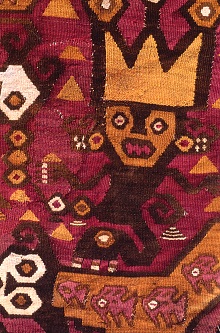Botschaften an die Götter
Textilien aus dem alten Peru
27 September 2009 until 3 January 2010

| ANNE WANNER'S Textiles in History / exhibitions |
| Deutsches
Textilmuseum Andreasmarkt 8 D-47809 Krefeld _____________________________ how to get there: PKW: A 57 Abfahrt Krefeld-Oppum/Linn P: Ortseingang Linn Streetcar from station: line 044-Rheinhafen, stop: Burg Linn |
tel:
++ 02151 / 946 9450 fax: ++ 02151 / 946 9455 e-mail: textilmuseum@krefeld.de internet: www.krefeld.de/textilmuseum Director: Prof.Dr. Brigitte Tietzel |
opening
hours: November 1st to 31st of March tuesday - sunday 11 am to 5 pm from April 1st to October 31 tuesday - sunday 10 am to 6 pm guided tours: on request entrance fees: adults: Euro 4.50 children, reduced: Euro 2.50 further reductions: see homepage |
| The German
Textile Museum is located at the Andreasmarkt in
Krefeld-Linn. The market is the secular centre
of the small mediaeval town around the castle. One side
of the square belongs to the textile museum. Half of the
building is of a modern construction, while the other
half betrays its past as an imposing residence of a mayor
of Linn from the 18th century. In an appropriate setting
one of the greatest museum treasures of the town of
Krefeld is accommodated here: almost 30.000 textiles from
all over the world, produced over a period of more than
2.000 years. The museum collection was based on the former collection of patterns started as long ago as 1880 for the Royal Prussian School of Weaving. In the 1930s ownership of the collection, which had grown considerably in the meantime, was transferred to the town of Krefeld. A good number of the treasures contained in the collection stem from the production of velvet and silk, which has made Krefeld a city since the 18th century and the inhabitants of the town connoisseurs of these luxury items. In order to preserve the highly sensitive materials and their colours for as long as possible the textiles are stored in a carefully air-conditioned archive. For this reason the museum does not have a display collection which is accessible to visitors. Changing exhibitions of the items stored by the museum and other museums provide an insight into the variety of the textiles and the comprehensive Krefeld collection. Between the exhibitions the museum remains closed. In addition, visitors have a library with adjacent reading room permanently at their disposal. Please contact us to inquire about the theme of the relevant exhibition! Regular guided tours take place every Wednesday and Sunday at 3 pm. Other guided tours and guided tours for children are available by appointment. |
Botschaften an die Götter |
| Press release: In Peru wurden mehr Textilien gefunden, als in allen anderen Ländern der Welt zusammen. Ihre Fundorte, Gräberfelder im konservierenden Wüstensand, lagen in einem etwa 2.000 km langen, zumeist trockenen Küstenbereich am Pazifischen Ozean. Im Bereich der mittleren und südlichen Küste wurden die meisten Textilien gefunden, entweder auf einzelnen Friedhöfen in der Nähe früher Siedlungen, oder aber in größeren Nekropolen und in bedeutenden Wallfahrtszentren (Paracas, Ancón, Pachacamac). Im Ganzen umfasst die Textilkunst des Alten Perus einen Zeitraum von etwas mehr als 2000 Jahren, vom Höhepunkt Chavins (ca. 600 v. Chr.) bis zur frühen Kolonialzeit (ca. Mitte 16. Jahrhundert nach Chr.). Obwohl nicht aus allen präkolumbischen Kulturen Perus Textilien in gleicher Weise überliefert sind, ergibt sich dennoch ein recht gutes Bild der bevorzugten Techniken. Insgesamt kann man in der Ausstellung Textilfunde aus 15 Kulturen betrachten (etwa in zeitlicher Abfolge): Chavin, Paracas, Recuay, Nasca, Moche, Tiahuanaco-Huari, Pachacamac, Lambayeque (Sicán), Chimú, Chancay, Ica-Chincha, Chuquibamba, Chiribaya und Inka. |
Die zumeist bemalten, leinenbindigen Gewebe der Chavin-Zeit waren die frühesten, die sozusagen die Botschaft dieser Kultur ins Land trugen. Andere textile Techniken, wie Stickerei und Broschur, entwickelten sich ebenfalls bereits zu dieser Zeit. Daneben wurden in den Gräbern Perus überaus feine Doppelgewebe, Schlitzwirkereien und in Plangi-Technik gefärbte Textilien aus den Materialien Wolle und Baumwolle gefunden. Eine besondere „peruanische Spezialität", die sogenannten Partialgewebe, bei denen nicht nur der Schuss zur Musterbildung unterbrochen wird, sondern vorbereitend auch die Kette, lässt sich nur in Peru nachweisen, sonst in keiner anderen Weltkultur. Die Ausstellung im Deutschen Textilmuseum zeigt eine große Anzahl von Textilien aus dem Alten Peru, die einer privaten Sammlung entstammen und die Vielfältigkeit und Schönheit der peruanischen Textilkunst in eindrucksvoller Weise belegen. Gegliedert wird diese umfangreiche Schau in die Themenbereiche kultureller Hintergrund, Textiltechnik und Ikonografie. Ergänzt wird die Ausstellung durch einige peruanische Textilien aus eigenem Bestand.
|
|
| home content | Last revised September 12, 2009 |